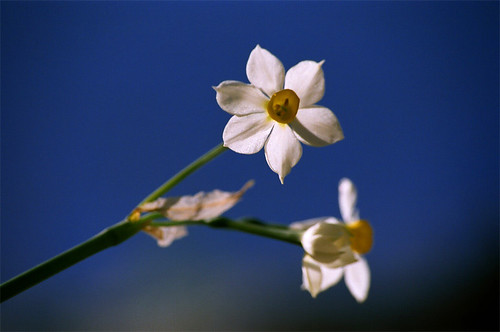Back to the drawing board with my Coal Harbour perfume. It seems like the timing could not be more important now with the terrible oil spill. So I return to a perfume that is inspired by the smell of jet-fuel mingled with sundries barnacles and seaweed at low tied. That and some fresh-cut grass. And elderflowers (which are in season again - a whole month earlier than they should).
Another scent that is typical of spring, and unique to these northern parts of the world are more sweet-balsamic notes, some of which I can attribute to the cotton trees, some to a mysterious tree whose flowers I've never seen, but smells almost of vanilla and labdanum combined and always stops me on my tracks overtime I pass by it. Perhaps I shall add some sappy balsam poplar buds absolute to this perfume... Narcissus absolute does not seem like a bad idea either, although I should really keep it for special occasions! It is such a rare essence, and oh so precious. However, with its hay-like, warm-spicy and slightly balsamic attitude, I might just have to dip into that cookie jar once again for the Coal Harbour perfume. And I might as well grab some crystallized-sugar-like liatrix absolute while I'm at it!
This time I tried to illuminate the rustic, ambery, hay-like aspects of narcissus and bring to the fore the scenery of Mediterranean winter. Although relatively mild, the winter in this region is a very dramatic season: thunderstorms, hail, floods (especially in the desert). Kinda like the storm that is attacking the West Coast right now.
Just as fast as these storms appear, they also disappear. And then the mushroom pop up, the bulb flowers bloom, and nature awakens to life thanks to the power of water. The next day would be as sunny and bright as an egg yolk, and as the central cup of Narcissus tazetta.
To capture in a bottle that feeling of picking flowers after the storm, I used quite a lot of pine essences, which are a very wintery scent - pine moos, pinewood, and pine needle aboslute, with its slightly sour, off-note of crushed needles and crackling branches. The balsam poplar buds absolute accentuate the honeyed floralcy of the narcissus.
Base notes: Pinemoss, Pinewood, Spikenard (Green), Africa Stone Tincture, Clary Sage Absolute 74%, Pine Needles Absolute, Liatrix Absolute, Musk Compound
Heart notes: Narcissus Absolute, Coffee Flower Absolute, Balsam Poplar Buds Absolute, Orris CO2, Orris Tincture
Top notes: Szechuan Pepper CO2, Ylang Ylang Extra (Organic), Palmarosa
The verdict: Although I really liked this version, and how the supporting florals did to the narcissus, I felt lack of clarity in the concept. I felt that I had to *either* go fully with the wintery, puddle concept; *or* go fully with the dusky, mysterious olfactory concept that I first conceived when working with the narcissus absolute in the first round. Not both. So I had at least two more trials to go... Which I will tell you about next week.
While the starting point for this was clearly and simply winter, rain and narcissus, it strayed a bit and became more floral. A turn of events that was most welcome.
I began with a core statement of narcissus absolute, on a backdrop of wet-woody, mushroomy and unusual tree notes: pinewood, fire tree, green spikenard, pinemoss and a tinge of bourbon vetiver. To add more body to the narcissus heart, and make it more floral and less spicy-green, I've decorated it with a hint of rose and ylang ylang. Palmarosa and Szechuan pepper add a lift, and also a unique floralcy to the top notes. In addition, I've utilized liatrix absolute in the base, to give a diffusive sweetness. The latter made it feel too "perfumey" in an old-fashioned, powdery way*. So I had to start another bottle, again.
But I have to admit: coming back to it now, many months after its creation (it was made in early March 2014), the liatrix mellowed a bit, which is nice of her. It has a more distinctive, green-floral yet a little juicy-sweet and almost refreshing at the same time. Together with the Szechuan pepper, it gives off more of the crushed-leaves feel in the beginning, despite the lack of glabanum - which is a nice surprise in my book.
* Kinda like Rive Gauche or Je Reviens - great perfumes, but with loads of coumarin that makes them feel quite dated and heavy for today's tastes.


